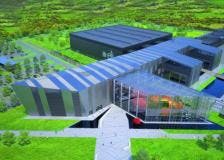The Extreme Light Infrastructure (ELI) Attosecond Light Pulse Source (ELI-ALPS; Szeged, Hungary) announced that Fastlite (Valbonne, France) has been award the contract to develop the project's mid-infrared laser system. Financial support for this implementation phase of the ELI-ALPS Research Centre is 119 million euros, 85% of which is provided by the European Union's Regional Development Fund. The project was launched at a ceremony in Budapest. Fastlite is now responsible for the detailed engineering design, construction, delivery, and installation of the system in Szeged.
Prof. Károly Osvay, research technology director of ELI-HU Non-profit, noted the scientific importance of the agreement, "This mid-infrared laser operates at the wavelength around 3.1 micrometers where water absorption decreases significantly. With the use of its 100 kHz repetition rate, it is an excellent tool to carry out low yield, ultrafast spectroscopic experiments on samples containing water; for example tissues and cells. A few cycle laser system operating at this unique wavelength provides us also with the opportunity to generate keV--the so called x-ray photons."
ELI is a European ESFRI project for the investigation of light-matter interactions at highest intensities and shortest time scales. It is a laser facility that aims to host some the most intense lasers world-wide, develop new interdisciplinary research opportunities with light from these lasers and secondary radiation derived from them, and make them available to an international scientific user community. The facility is based on four sites. Three of them are presently being implemented in the Czech Republic, Hungary, and Romania, withinvestment exceeding 850 million Euro, mostly coming from European Regional Development Funds (ERDF).
Related article: The ELI aims to break down the vacuum by LFW Contributing Editor Jeff Hecht
VIDEO of plan for ELI-ALPS in Szeged, Hungary, currently under construction:

Conard Holton
Conard Holton has 25 years of science and technology editing and writing experience. He was formerly a staff member and consultant for government agencies such as the New York State Energy Research and Development Authority and the International Atomic Energy Agency, and engineering companies such as Bechtel. He joined Laser Focus World in 1997 as senior editor, becoming editor in chief of WDM Solutions, which he founded in 1999. In 2003 he joined Vision Systems Design as editor in chief, while continuing as contributing editor at Laser Focus World. Conard became editor in chief of Laser Focus World in August 2011, a role in which he served through August 2018. He then served as Editor at Large for Laser Focus World and Co-Chair of the Lasers & Photonics Marketplace Seminar from August 2018 through January 2022. He received his B.A. from the University of Pennsylvania, with additional studies at the Colorado School of Mines and Medill School of Journalism at Northwestern University.
